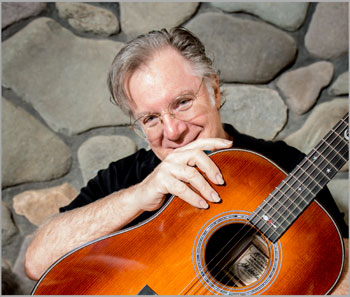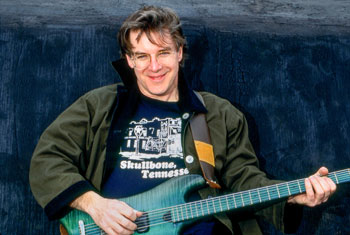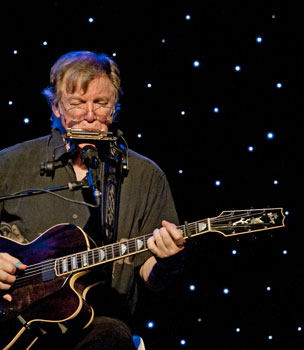“Richie Havens and I and John Hammond and Jose Feliciano were all the sort of bottom floor of the new little folk scene that was kind of a second generation after Tom Paxton and Dylan…”
John Sebastian Bringing Solo Show to MIM
A Conversation with John Sebastian
By Mariah Fleming

John Sebastian’s group The Lovin’ Spoonful rocketed an unprecedented seven singles into the top ten during the height of Beatlemania. On November 17th and 18th at 7:00 p.m. he’s bringing his solo show to the Musical Instrument Museum, and it’s more than a spoonful of music. In the past four decades, Sebastian’s songwriting has made a huge imprint on American music. Tickets for the November 17th show sold out, but you can still good tickets for November 18th if you act fast. For more information and tickets go to TheMIM.org
Sebastian grew up in in Greenwich Village in a musical household, where legendary songwriters like Woody Guthrie often visited. His father, a classical harmonica player, knew a who’s who of legendary musicians of the era. Sebastian’s music is a treasure trove of American ‘roots’ music. His body of work bears an unmistakable, irresistible quality. Blues, folk and jug band music informed his music during the1960’s rock revolution and he’s still spreading the gospel of American ‘roots’ music. Revered by his peers as well as his fans, he was inducted into the Songwriters Hall of Fame in 2008 and the Rock and Roll Hall of Fame in 2000.
Sebastian’s most recent recording is 2007’s “Satisfied”, a wonderful collaboration with mandolin master David Grisman. “Satisfied” hit #8 on Billboard’s Top Bluegrass recordings. Sebastian continues to write songs, but isn’t in a hurry to produce another recording. “Currently I’m happy to be bouncing around the country doing concerts,” he told me in a phone interview a few days ago. He was gracious, generous with his time, and our 40-minute conversation was punctuated with laughter. It was like talking to an old friend. I hope you’ll enjoy the interview as much as I did.
Q.Thank you for doing this, John.
A. (Laughs) Oh, I’m just glad that somebody’s interested!
Q.You were the first band I ever saw as a kid. My friend and I were right up at the edge of the stage, maybe two feet away from the band. How must it have been to have a bunch of teenagers crushing against the stage with two go-go girls behind you?
A. (Laughs heartily) Oh, that was something we were trying to make stop, that whole go-go girl, four guys with mop tops thing. The Spoonful were, how can I say this…the Spoonful, we really wanted pop success but we didn’t consider ourselves matinee idols. So that kind of ‘reflection adoration’ that was mainly caused by DJ's and people pumping children up about stuff, it didn’t feel quite right for us. But at the same time I guess it made our music stick.
Q.You grew up in Greenwich Village, your parents were very artistic…stop me if I’m wrong. Your mom was a radio comedy writer and your dad was a classical harmonica player. Did he play professionally?
A.Oh, yes he did. He played with the great orchestras of the world!
Q.So you had music all around you.
A.I did.
Q.Did you have any brothers and sisters?
A. I have a brother Mark. He’s a co composer on "Summer in the City."
Q.You must have had a lot of musicians of the era coming to your house.
A. I sure did. That was part of growing up where I did and at the time I was growing up. And the combination of having a mother in radio, where there were a lot of funny people in the house writing stuff and musicians as a result of my dad’s life…

Q.Do you think you got your skill in writing partially from your mom?
A.Oh, absolutely. She would also, for your entertainment, if you were sitting around while she was watching TV at night, take apart jokes and explain to you how “Oh, see, he went over, he did three jokes on the same subject and the third joke laugh was not as good.’ And this is the art that was her game.
Q.Did you always want to be a songwriter and were your parents supportive?
A. Once we started to show success I think both of my parents were very grateful that their kid could work in the arts and do ok. Because they knew, they had no false illusions about working in the arts. Because it is a hard job, especially on the terms they had done it. It’s not really a financial gratification kind of a goal.
Q.Was there ever anything else you thought you might do?
A.I guess…well, in prep school I thought I might become a vet. I was doing a lot of odd jobs at surrounding dairies and things. As time went on I had some success in school plays and thought I might be an actor. But all the while, I was learning more about guitar and that really was the focus.
Q.What was the first “aha!” moment you had listening to music, when you knew you wanted to do music?
A.Oh! “Don’t Be Cruel”! Let’s see, Scotty Moore [Elvis Presley’s guitarist], things like "Whole Lotta Shakin Goin’ On”. The first time you hear that pumping piano, that intro… listen to it on vinyl sometime! (laughs)
Q.Was the guitar your first instrument?
A. Well, yeah, pretty much. But the harmonica was my very first; I was already blowing on that when I was a kid.
Q.So because of your dad’s music, did you listen to people like Toots Thielman or what?
A.I particularly listened to people like Sonny Terry actually. Because of my father’s connection, I was able to talk to him several times and be able to ask a question or two of him. So, certainly Sonny. Toots, my father of course admired, and I do too. But Toots being more in a jazz world, socially I just never had any exchange.
Q. Do you remember the first song that you wrote, John?
A.It was called ‘The Little Piggy’s Waltz’. I was about 5 and my piano teacher at the time showed me how to write it down. And I still have a copy of that somewhere.
Q. Do you think you’ll ever record it?
A. Ah, NO! (laughs)
Q.Where’s the first place you played professionally and were you by yourself or with other musicians?
A.The first professional engagement was with a gentleman named Noel who ran a music store in New Hampshire. After I haunted his music store for 3 or 4 days playing anything that was on the wall or the drum kit or anything, he turned to me at closing time and said “We’re playin' the VFW and why don’t you come on and play drums” and I decided I’m not gonna say I don’t play drums! So I went and I tapped along. And that was my first professional engagement.
Q. How old were you?
A.I was 16.

Q. Did it go well?
A.It did! It did! (chuckles)
Q. So you had so much music in you it wasn’t such a big deal for you to play drums. I can’t imagine being able to walk in and just do that.
A.Well, remember, I’d been trying to do that for four or five years already. Like at prep school, I’d learned how to pick the lock on the band room and go in there and set up parade snares as if they were a drum kit and be able to get lost in that a little bit
Q.You made me think of Richie Havens when you were talking about playing the drums. He was one of my favorite singer songwriters and I always thought his guitar playing was like percussion.
A. Well, he said that. He said ‘I’m playing drums on the guitar’.
Q.When did you first see Richie Havens?
A.Oh, in Washington Square, Richie was the lead singer of a ‘doo wop’ group. Then very steadily, because both Richie and I and John Hammond and Jose Feliciano were all the sort of bottom floor of the new little folk scene that was kind of a second generation after Tom Paxton and Dylan and the folks that had gone before. This was sort of a new group, but it was all compacted into about a four or five square block area. So we were under each other’s feet all the time and we all knew each other intimately. I knew Richie’s process of learning how to play the guitar and it was really a matter of [Richie] being told from the stage by a songwriter named Freddie Neil, “You sound better than any of us! Learn to play a guitar, tune it to a chord for god’s sake and you’ll be kicking ass!” and Freddie was right. Richie did exactly that and evolved this entirely unique style of playing. And he was one of our most powerful performers.
Q. Fred Neil was such a wonderful songwriter. You worked very much with Fred Neil didn’t you?
A.Yes, very much.
Q.I was so sad when Fred Neil died. But it seems like the music of that era endures and means so much to people. Do your fans talk to you about what your music means to them and that kind of thing?
A.Yes, I get that kind of feedback and it’s really the greatest compensation for songwriters.
Q.You played the autoharp in Spoonful. Why the autoharp? What turned you on about that instrument?
A.It’s just an instrument I encountered in summer camp and I was learning how to play Carter style fingerpicking on the autoharp; that was a fascination. And when we started playing as a group I realized that if I came up with a song that was autoharp friendly and was played in the keys that the instrument had (laughs) because at that time the idea of changing felts and everything was just like surgery, you know? A lot of things like that are now common. People take harmonicas, autoharps and all kinds of things apart to fine-tune them. So I eventually put a De Armond ukulele contact microphone on the back of it and ran it through a large amp and that was really the sound for “Do You Believe”
Q.When you play your songs, does the memory of where you wrote it or the circumstance come back to you as vividly as it might for someone who’s listening to it?
A.Not always. I’ve been coasting on the emotion of it for a long time but the specificity of where I wrote it might disappear.
Q.What’s your writing process? Do your words come to you first, or the melody or what?
A.It always comes all different ways. Well, this is part of what my show is about so you’ll get a feeling for that at the show.
Q.What can we expect from you at the Musical Instrument Museum? And what do you know about MIM?
A.Well, its reputation precedes it, because a lot of musicians of my ilk have played it [MIM] and speak about it with great affection. So, as a guitar enthusiast as well as somebody who likes to travel far and wide to perform it’s doubly delicious.
Q. Are you going to have time to go through the museum?
A.Oh I’m sure I will! That show is now two days…it grew a little bit. So, I have two days and that would pretty much cinch it that I would spend some time in that museum,
Q.If they asked you to loan an instrument to the museum for exhibition is there something special you’d want to loan?
A.Well (pauses) I don’t know that I would have something that would interest them, because my instruments are not collectors’ instruments. Because I worked in a shop quite early on, I was always more interested in the newer stuff that was coming out. So, you know, everything that I have is kind of ‘utility’. It’s not that they’re not good. I’ve got a couple of good Gibsons, a couple of good Martins and several Heritages which are made in Kalamazoo, and that is sort of my main body.
Q.Can we talk a little about your collaboration with David Grisman on "Satisfied"?
A.You know, that happened quite spontaneously. We sort of joined on a particular benefit that happened near him and did this concert, having not really had any time to hang out since we’d been in a jug band together in 1962.
Q.Wow, 40 years?
A.Yeah. I had hired David occasionally to come in and play mandolin, ‘cause if it’s mandolin, I want Grisman, and luckily he could always do it. He is kind of a frequent hired gun for me. And so we had seen each other, y’ know, like every 6 or 7 years, but this was an opportunity to have a really good spontaneous event.

Q.It’s a beautiful album.
A.Well, thank you very much. Really, it was a terrifying approach, which I had really not ever done. I like my tinkering time, I do. But David really introduced me to this ‘Get on the bus and go!’ kind of an approach and it’s terrific. I really enjoyed what we were doing that day.
Q.Where did you record “Satisfied”?
A.In David’s garage! (Laughs) I’m downplaying it, but David has a really tight little system that ignores digital as much as it possibly can, even as it does record some really good digital information. But it is a very compact affair.
Q.So you were able to record it live, like in the good old days?
A.That’s right.
Q.Can we talk a little about Woodstock?
A.(Sounding resigned) Ah, sure. Let me tell you this. I was not the star at Woodstock. Of course, standing on the stage and playing was remarkable. But the audience was the star there. And that’s the way it was that weekend. There were a few amazing performances, several of them undocumented. Creedence Clearwater was absolutely fabulous that weekend and nobody knows. [John] Fogerty didn’t want the footage out. He didn’t want to join in the movie thing because he didn’t like their performance. And of course there was Sly [Stone], which was fabulous. But really, it was about people coping with adversity, so the audience is really what raised it above. I’m on record at great lengths on this subject. (laughs)
Q.Are you going to write a book about your musical life?
A.I don’t know. I’m more of a performer using that material. So I don’t know what incentive I would have to write it down and then forever be chained to that particular version. (laughs)
Q.So, what are you working on now? Anything different?
A.Currently I’m happy to be bouncing around the country doing concerts. I do writing with Johanna Hall who’s a wonderful composer/co composer, so that process goes on. It’s certainly much slower than when people need two albums in a year. It goes, but there’s more to life, you know?
Q.Do you live up in the Woodstock area?
A.Yes I do.
Q. I read about a Woodstock museum in Bethel Woods.
A.Yeah. The Bethel Woods Museum is a very interesting museum dedicated to the Woodstock festival and it tells a little bit about the area and so on. It is about 50 minutes from the town of Woodstock. And of course, this discrepancy probably created a huge income spike for Woodstock, the actual town, in years after the concert, as people would come here thinking that they would find a rolling field and Yasgur’s farm. (chuckles)
Q.Is there anything else you want to talk about or tell me about the show you’re going to do?
A.Well, I can certainly tell you that it’s going to be just me and my funny 90’s arch top. As long as we’re in the [Musical Instrument] Museum we might as well be specific. And a Citron baritone guitar, and harmonicas and…nobody (laughs) except the audience.
Q.Are you going to come out after the show and talk to people?
A.Oh yeah, it seems like the general pattern is to do the show and then dry off and go out and sign some vinyl and sell some jug band CDs which are kind of a hard thing to find. So yeah, I think it’s usually pretty casual…. (dog barking) I’ve got to get my dog to shut up. He wants to be in on this! (laughs)
Q.What kind of dog do you have?
A.I have a cross between a Schnauzer and a Shih Tzu. Wicked cute. Women cannot walk past this dog. If I were a single guy, he would be the best wingman in the world. But my wife is very patient about the whole thing and explains to her friends “No, no. He walks through town with that dog and leggy women in spikey heels just suddenly appear! They’re not interested in 70-year-old guys like him. It’s the DOG!” (laughs heartily)
November 5, 2013
Contact the author of this article at Editor@MusicAndMoreAZ.com.